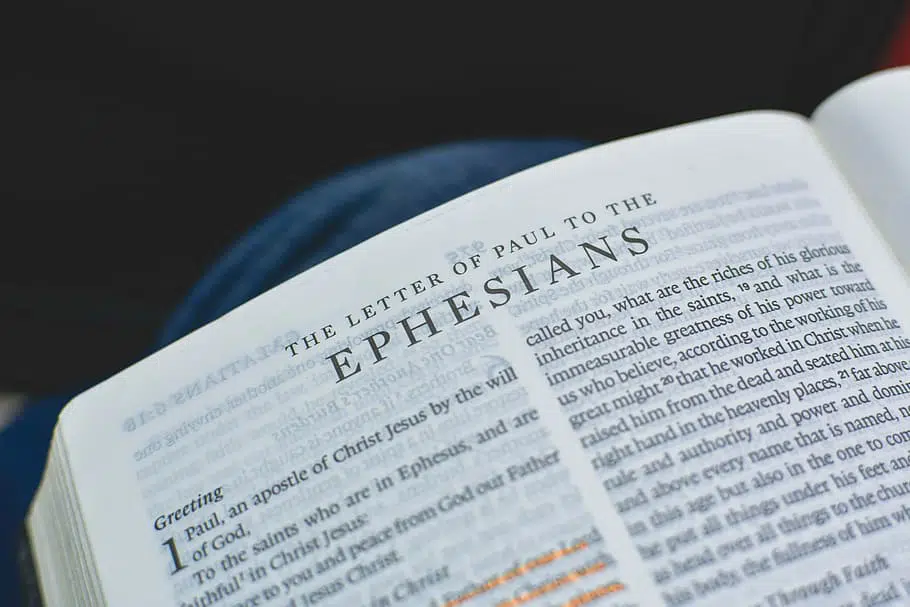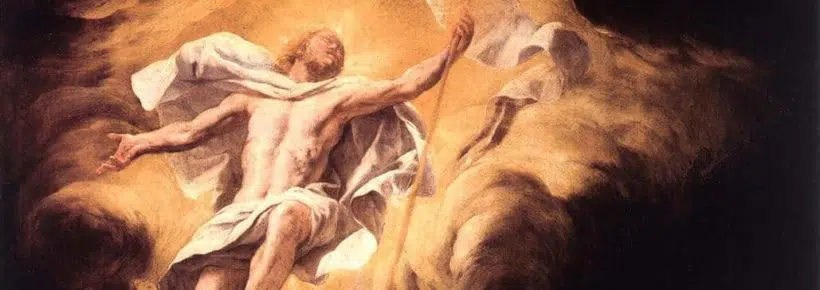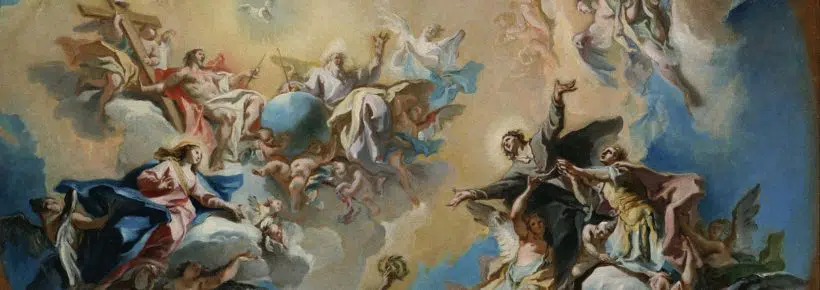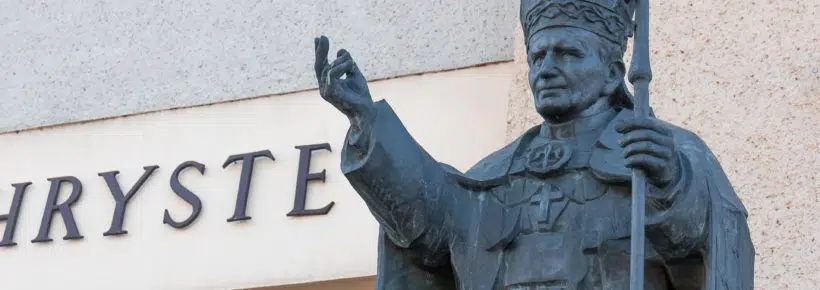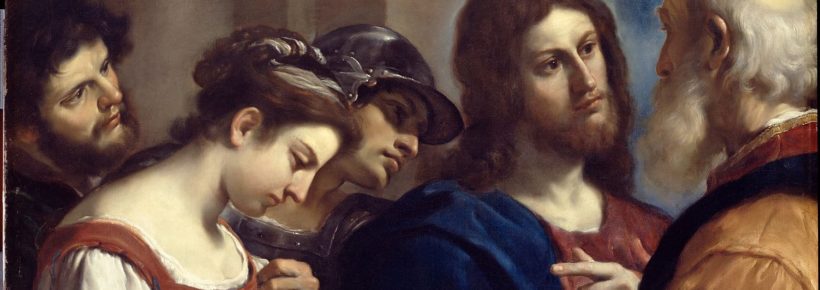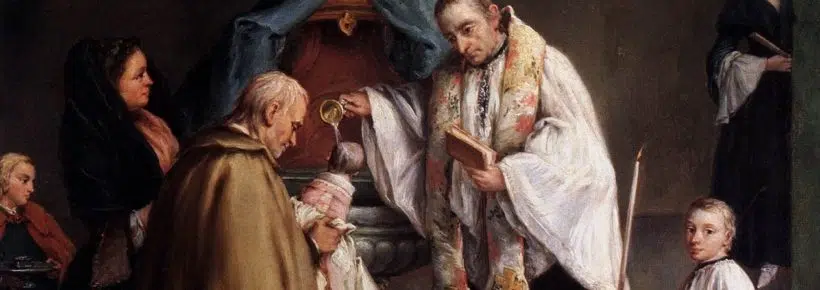Previous articles in this series:
- What Is the Theology of the Body?
- Human Dignity and the Conjugal Meaning of the Body
- The Beginning: The Original Unity of Man and Woman
- Purity of Heart
- Resurrection of the Body
- Christian Virginity and Celibacy for the Kingdom of God
Next article in this series:
In our previous article we reflected on the topic of Christian virginity and celibacy for the Kingdom of God as explained in the fourth cycle of catechesis (73-86) of St. John Paul II on the theology of the body. In this article, we continue our reflections, moving to the fifth cycle of the Holy Father’s catechesis (87-113), which treats of the Sacrament of Marriage.
The subtopics we are going to cover in this article are:
- The importance of the Letter to the Ephesians’ discussion of the Sacrament of Marriage
- Whether this passage debases women by subjecting them to their husbands
- The main point of this passage from Ephesians
- The relationship between Baptism and Matrimony
- How we know that Matrimony is indeed a sacrament
- Other teachings of St. John Paul II on Matrimony
1. The Sacrament of Marriage in Ephesians
As in previous cycles of his discussion on the theology of the body, St. John Paul II reflects on the different aspects of a key biblical passage. In this case, the key passage is Ephesians 5:21-33:
21Be subject to one another out of reverence for Christ. 22Wives be subject to your husbands, as to the Lord. 23For the husband is the head of the wife as Christ is the head of the Church, his body, and is himself her Savior. 24As the Church is subject to Christ, so let wives also be subject in everything to their husbands. 25Husbands, love your wives, as Christ loved the Church and gave himself up for her, 26that he might sanctify her, having cleansed her by the washing of water with the word, 27that he might present the Church to himself in splendor, without spot or wrinkle or any such thing, that she might be holy and without blemish. 28Even so husbands should love their wives as their own bodies. He who loves his wife loves himself. 29For no man ever hates his own flesh, but nourishes and cherishes it, as Christ does to the Church, 30because we are members of his body. 31“For this reason a man shall leave his father and mother and be joined to his wife, and the two shall become one flesh” [Genesis 2:24]. 32This is a great mystery, and I mean in reference to Christ and the Church; 33however, let each one of you love his wife as himself, and let the wife see that she respects her husband.
In order to understand and appreciate this passage, we should see its context within the letter, whose outline is as follows (chapters and verses are indicated in parenthesis):
- God’s eternal plan of salvation in Christ (1-3)
- Moral guidance to the Church (4-5)
- The Sacrament of Marriage (5:21-33)
- Moral guidance to the family (6:1-9)
- A call to spiritual combat (6:10-20)
- Farewell (6:21-24)
The passage we are analyzing is “sandwiched” between the announcement of God’s eternal plan of salvation (part 1) which ought to be lived out first within the Church (part 2), and then also within the family, which is part of the Church (part 4), but which has its origin in Christian Marriage (part 3). The Sacrament of Marriage then is placed within the context of the Church’s moral obligation to respond to God’s plan of salvation in Christ, a plan that was designed by God but hidden in Him “before the foundation of the world” (1:4), but that has been revealed in Christ “as a plan for the fulness of time, to unite all things in him, things in heaven and things on earth” (1:10).
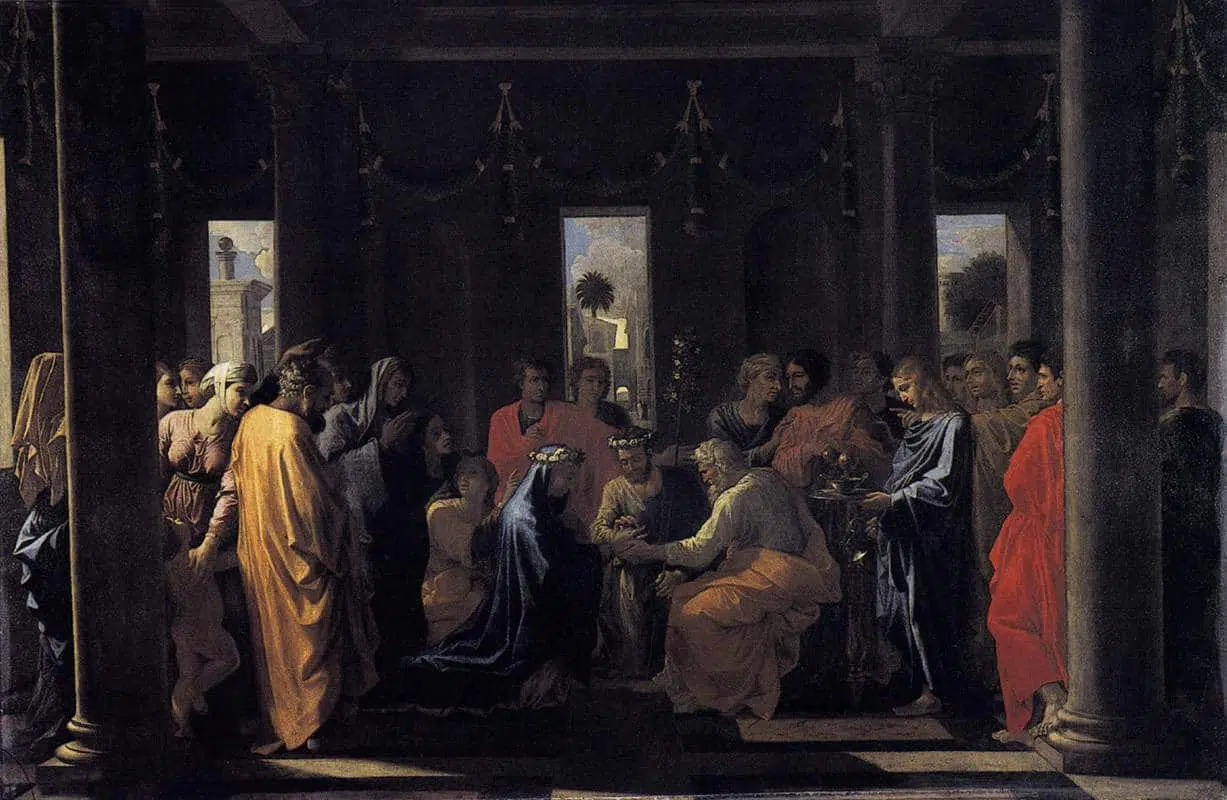
The Sacrament of Marriage (Nicolas Poussin)
So, we see that the passage on the Sacrament of Marriage has a very important location within the epistle. Saint Paul is telling us not only that this sacrament is very important, but also that spouses ought to live out God’s eternal plan of salvation in their married lives first, and then in the family they bring about through procreation. God’s eternal plan of salvation is lived out in history through His Church, within the Church through marriage, and, thanks to marriage, within the family. And, of course, as the Church fulfills God’s plan of salvation in Christ, the whole world is also made part of this plan as it is incorporated into the Church by means of evangelization, conversion, and Baptism. By fulfilling the plan God conceived in His Heart from all eternity, we are fleshing out His beautiful design in human history, in the daily living of our Christian lives within our marriages and our families!
2. “Wives, Be Subject to Your Husbands”: Debasing Women?
Not at all! If you read carefully, we see that in verse 25 it says that husbands ought to love their wives as Christ loved the Church and gave himself up for her. Wow! That kind of love would never be demeaning or disrespectful. On the contrary, husbands ought to love their wives by giving their lives for them. This giving of their lives is lived out in service to them. This service is threefold: to protect, provide for, and guide their wives and children.
St. Joseph, for example, was not holier than Mary, and certainly not holier than Jesus! And yet, God chose him to head His Holy Family. This is clearly proven by the fact that God sent an angel to Joseph in a dream (not to Mary or Jesus) on two occasions: first to protect Mary and Jesus from the murderous intentions of King Herod by fleeing into Egypt (Matthew 2:13), and several years later when Herod had died, to return to Israel (Matt. 2:19). When Joseph heard that the evil king Archelaus, son of Herod, was reigning in Judea, and was afraid to go there (Matt. 2:19-20), he was warned in a dream—the sacred text doesn’t say if it was an angel or God Himself—not to stay in Judea but to go to Galilee (Matt. 2:22).
We can be sure that Saint Joseph, the greatest among the saints after Mary, was a loving, gentle and kind guide, and courageous protector of Mary and Jesus, as well as a responsible provider through his hard work as a carpenter. The Gospel of Saint Luke 2:51 tells us that Jesus “was obedient to them” (Mary and Joseph). Can you imagine, the God-Man Jesus and His Mother conceived without sin, obeying a man who was not conceived without sin and certainly was not God? Today we need husbands and fathers like Saint Joseph, who was pure in heart and body, and obedient to God in everything.
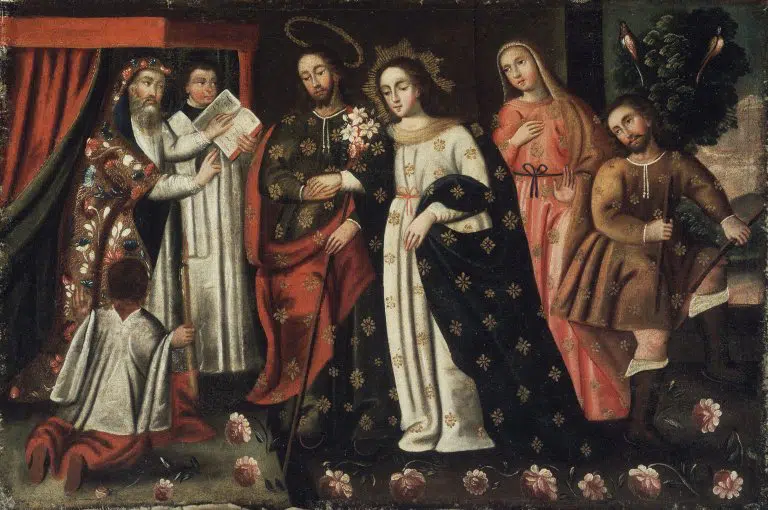
The Wedding of Mary and Joseph (from the Brooklyn Museum)
Finally, notice that Ephesians 5:21 begins this passage by saying that husbands and wives must be “subject to one another out of reverence for Christ.” This reverence for Christ is the same as the gift of fear of the Lord (which really means an absolute respect for Him). This is the seventh gift of the Holy Spirit according to Isaiah 11:1-2. Therefore, the headship of the husband must be exercised within the context of a reverence for his wife, analogous to the fear of the Lord. This means that husbands must regard their wives in high honor and recognize the wisdom and talents that God has bestowed on them, as the Old Testament describes in Proverbs 31:10-31.
3. The Main Point of this Passage from Ephesians
The main point of this passage is that the husband-wife relationship has been designed by God from all eternity to be an image of the Christ-Church relationship. This marital relationship must reveal and make present the plan of God. Therefore, we understand better the meaning of the unity between Christ and His Church in the light of the unity of husband and wife in Christian marriage. And in turn, we understand better the unity between husband and wife in Christian marriage in the light of the unity between Christ and His Church. Each relationship illumines the other.
The other analogy used to explain the marital relationship is that of Christ as Head and His Church as His Body, which the headship of the husband and the respect towards him from the wife (see verse 33) ought to reflect also.
The main point of all this, however, is that the special grace of this sacrament is making present the marital union between Christ the Head and His Body, the Church.
Notice that Christ becomes the husband of His bride the Church precisely by giving himself to Her. Verse 25 says “Husbands, love your wives, as Christ loved the Church and gave himself up for her. It was in the “bed” of the cross where Christ consummated his marriage to His Church. The Fathers of the Church have taught that the Church issued forth from the wounded side of the “dormant” Jesus, as Eve was created from the side of the sleeping Adam. By being the Redeemer, Christ becomes the Husband of His Body, the Church.
All of the above implies that Christ loves us (His Church) with a spousal love. God’s love is certainly that of a Father, but by the gift of Jesus, each one of us receives Christ as the husband of our souls. Therefore, Jesus is the Husband of both of His Church as a whole and of each of us individually, since each one of us is a member of the Body of Christ, and Christ Himself is the Head of His Body.
Another implication of Ephesians is the fact that we can clearly see the theology of the body at work here. It is through the body of Christ that we are redeemed. And by means of this redemption, Christ makes us members of His mystical (spiritual) body, the Church.
The analogy of the body is indeed very powerful and foundational, not only to the Sacrament of Marriage, but to the rest of the sacraments. This is especially true of the Eucharist, through which we unite ourselves physically to the Body and Blood of Christ and spiritually to one another, thus making and re-making the Church with each celebration of the Eucharist. Therefore, we can say, as the doctrine of the Church teaches, that the Eucharist makes the Church, and the Church, through her priests and bishops acting as Christ the Head, makes the Eucharist.
4. Matrimony, Baptism, and the Eucharist
The passage from Ephesians does not mention Baptism or the Eucharist. Isn’t it through Baptism that we are incorporated into Christ, thus becoming members of His Body? And isn’t it through the Eucharist that we are united to Christ and nourished on our way to Heaven?
Certainly so. But actually, Ephesians does allude to both Baptism and the Eucharist. Verse 26 says that Christ cleanses her Church “by the washing of water with the word.” This washing of water and this word are the essential components of the Sacrament of Baptism, in which water is poured on the new Christian accompanied by the words of the baptizer, “I baptize you in the Name of the Father, and of the Son, and of the Holy Spirit.”
Moreover, this cleansing alludes to the fact that through Baptism we are cleansed from original sin (and even personal sins in the case of adults). Verse 27 attests to this cleansing: “…that he might present the Church to himself in splendor, without spot or wrinkle or any such thing, that she might be holy and without blemish.”
Verses 28 and 29 allude to the Eucharist: “28Even so husbands should love their wives as their own bodies. He who loves his wife loves himself. 29For no man ever hates his own flesh, but nourishes and cherishes it, as Christ does to the Church”. Christ lovingly nourishes the Church through the Eucharist, that is, by giving us His own Body, Blood, Soul and Divinity in Holy Communion.
5. Matrimony as a Sacrament
We have already said that the specific grace of the Sacrament of Marriage is to make present the union between Christ and His Church. The sign of Matrimony is composed of two elements: the vows that groom and bride exchange during their wedding and the conjugal act that consummates their marriage.
That conjugal act and the future conjugal acts must always ratify the words exchanged at the wedding. In other words, the physical union between husband and wife must express the truth intrinsic to such act, expressing the wedding vows of loving each other for life and of procreating and educating new members of the Body of Christ. Only in this way will the body language of the husband and wife truly express the truth of the conjugal meaning of the body: the capacity that God has inscribed in the human body to express true love always open to life.
In the passage from Ephesians, the foundational Old Testament text regarding marriage is cited in verse 31: “For this reason a man shall leave his father and mother and be joined to his wife, and the two shall become one flesh” (Genesis 2:24).
But the key verse is really verse 32: “This is a great mystery, and I mean in reference to Christ and the Church.” Notice that St. Paul does not say “sacrament” but “mystery.” Similarly, we saw above that the plan of God for our salvation was “hidden in Him before the foundation of the world” (1:4). In other words, it was a mystery that God later revealed through His Son in the fulness of time.
Through a long process of reflection, the Church came to understand the profound relationship between mystery and sacrament. The Church defines the sacraments as “efficacious signs of grace instituted by Christ and entrusted to the Church, by which divine life [grace] is dispensed to us” (Catechism of the Catholic Church 1131). By means of the sacraments and the liturgy, the Church makes present God’s acts of salvation in history. The greatest example is the Eucharist, which makes present for us here and now the one and definitive divine act of salvation, that is, the sacrifice of Christ on the Cross. The Eucharist does not repeat that act of salvation, which took place once and for all. But it does make that act of salvation present sacramentally, that is, by means of signs.
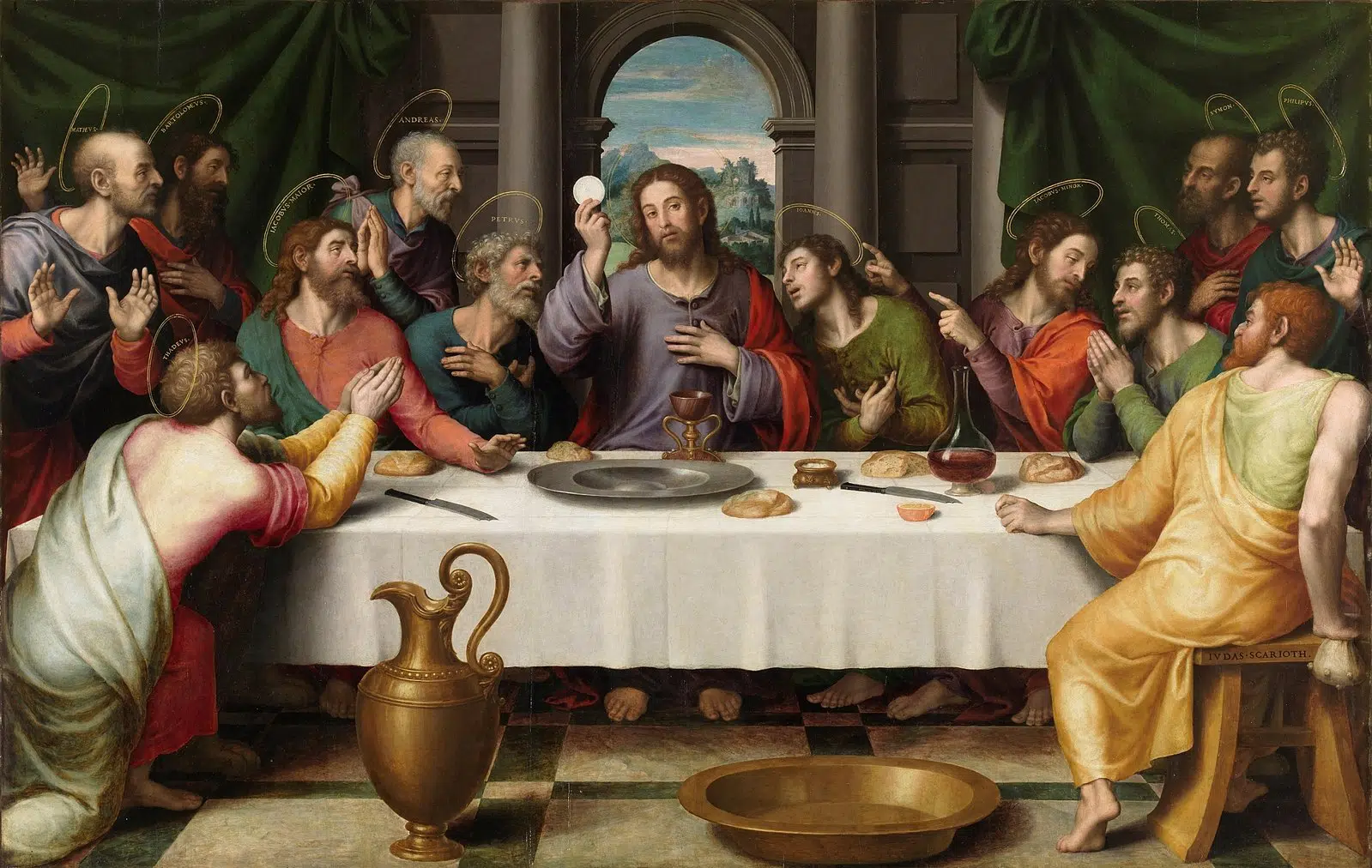
The Last Supper (Juan de Juanes)
Now, when St. Paul refers to the “great mystery,” he is thinking of the beginning of the Letter to the Ephesians, where he lays out God’s great plan of salvation, a plan first hidden (a mystery) but later revealed in Christ. The sacraments of the Church, and in particular the Sacrament of Marriage, make this mystery present for us.
Moreover, notice that St. Paul adds this key phrase in reference to the mystery: “I mean in reference to Christ and the Church” (verse 32). In other words, the real marriage, the real covenant is that between Christ and His Church (and by extension all of humanity). Our marriages are also real, but they must reflect and make present the marriage between Christ and His Church.
Therefore, even though St. Paul does not use the word “sacrament,” his meaning of the word “mystery” is practically identical with it and thus constitutes the sacramentality of Christian marriage. Again, this sacramentality of Christian marriage is based on the fact that the unity between a Christian husband and a Christian wife was designed by God to reveal and to make present Christ’s unity with His Church. And this unity between Christ and His Church is the culmination of God’s plan of salvation, since salvation is nothing else but being freed from sin in order to unite ourselves to God in Christ.
6. Other Teachings of St. John Paul II on Matrimony
In catechesis 109-111, St. John Paul II reflects on the beauty of conjugal love as expressed in the book of the Song of Solomon of the Old Testament. This book is an allegory of the love between Yahweh and Israel, but it is also a poetical description of conjugal love in the age of innocence, that is, before the advent of original sin. As such, it is an idealistic presentation of the conjugal love between a man and a woman.
However, the Song of Solomon, as idealistic as it is, falls short of a perfect description of conjugal love. Verse 6 of chapter 8 (the last chapter) says that “love is strong as death.” It does not say that love is stronger than death. As such, this book remains open-ended, open to further fulfillment.
We will have to wait until the coming of Christ for the fulfillment and perfection of conjugal love. This conjugal love is, of course, that of Christ for His Church. Christ loves His Church with a perfect love. Moreover, Jesus overcame death by His Resurrection, thus demonstrating that God’s Love is indeed stronger than death. The first letter to the Corinthians (13:8, 13) echoes this fulfillment by stating that “love never ends” (v. 8) and that “faith, hope, and love abide; but the greatest of these is love (v. 13).
The love between Christian married couples must also be a love stronger than death, a love that grows until death, and endures even beyond death into Eternal Life.
St. John Paul II ends this cycle by reflecting on the beautiful love story described in the Book of Tobit from the Old Testament. But this story unfolds after original sin. Therefore, the conjugal love between Tobias (Tobit’s son) and Sarah must not only be stronger than death but must actually engage in spiritual battle against the forces of evil, including demonic forces.
Sarah had lost her seven previous would-be husbands the very night of their wedding because of the murderous Demon Asmodeus (see 3:7-8). She was falsely accused by her father’s maids of killing her husbands, and so grieved that she thought of committing suicide. But Sarah decided to entrust herself to God instead (see 3:10-15).
Then Tobias arrived, accompanied by the Archangel Saint Raphael disguised as a hired companion. Saint Raphael (whose name means “Yahweh heals”) gave Tobias a mysterious fish with which the young man would make the Demon flee to Egypt, where Saint Raphael bound him (see 8:1-3). Then Tobias and Sarah joined in prayer, asking the Lord to protect them; He did, and they were able to consummate their marriage (see 8:4-19).
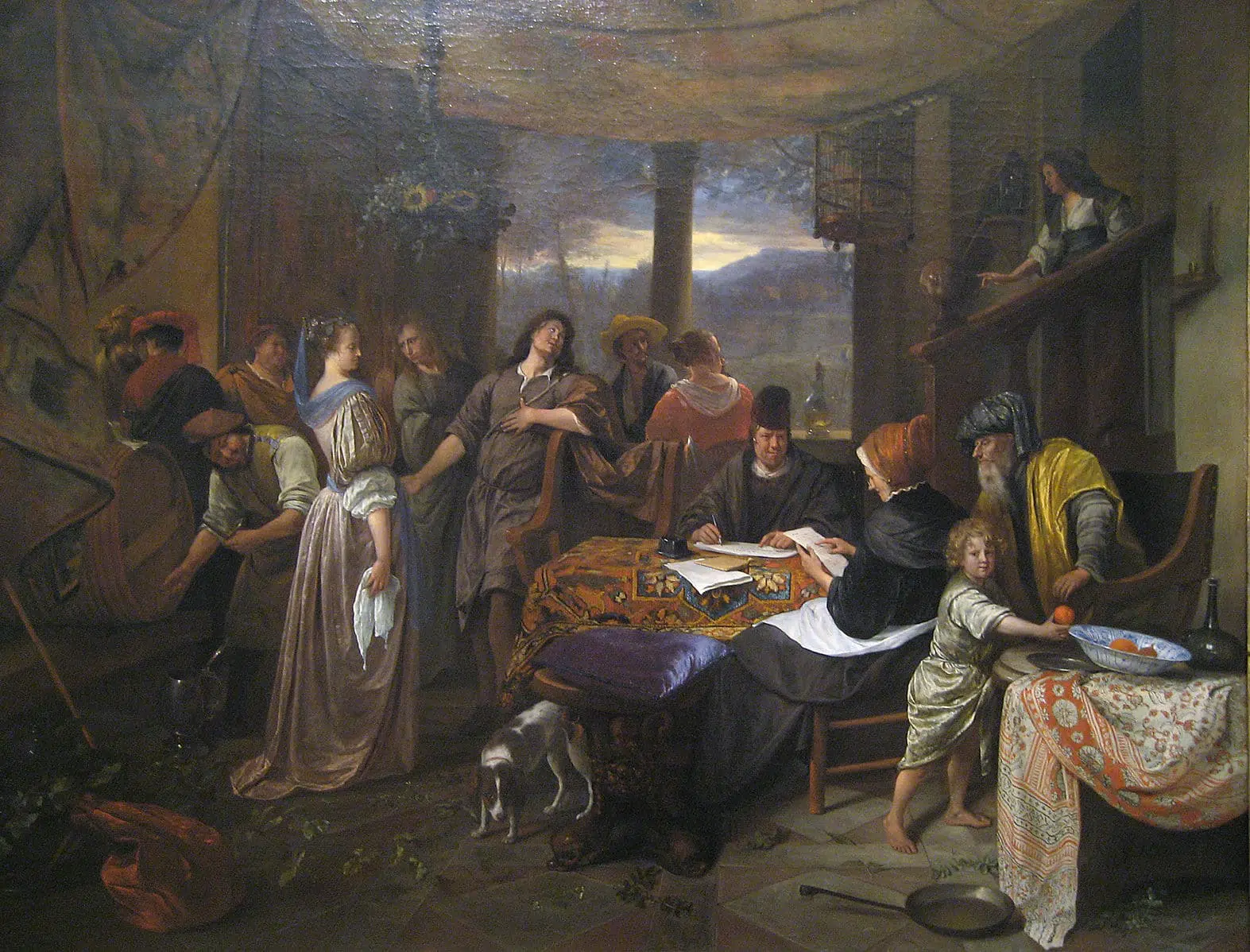
The Marriage of Tobias and Sarah (Jan Steen)
So, in this case the Word of God teaches us that conjugal love must be not only tender and strong but also willing to fight and overcome spiritual evil through prayer and a life of sanctity.
Final Thoughts
With this beautiful and realistic reflection on the love story of Tobias and Sarah, St. John Paul II ends his catechesis on the Sacrament of Marriage and prepares the way to reflect on the greatest of God’s gifts to married couples: the gift of children. Hence, the next cycle of catechesis will continue to reflect on conjugal love as the essence of marriage, but a love that must always be open to life, the greatest gift. That is why our next article will be entitled “Love and Fertility.”
Previous articles in this series:
- What Is the Theology of the Body?
- Human Dignity and the Conjugal Meaning of the Body
- The Beginning: The Original Unity of Man and Woman
- Purity of Heart
- Resurrection of the Body
- Christian Virginity and Celibacy for the Kingdom of God
Next article in this series:
Related Content
Adolfo is the Director of Education for Hispanic Outreach for Human Life International and of HLI's Hispanic outreach arm Vida Humana Internacional. He has a Masters in Theology from St. Vincent de Paul Regional (Major) Seminary and a License in Moral Theology from the Alphonsian Academy in Rome.
Adolfo has traveled frequently to VHI’s affiliates in Latin America to give talks, training sessions, and media interviews. He has authored and co-authored books, articles, reports, and a pro-life training course for Hispanics in the U.S. Adolfo has also participated in the production of two TV pro-life series in Spanish, which have been aired through EWTN en Español.


